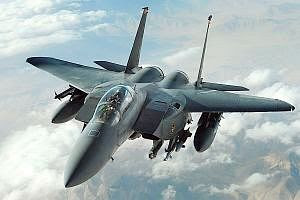The Air Force is in the early phases of a fleet-wide technological upgrade to the F-15 fighter jet to keep it in the air through 2035 and beyond, service officials said.
The upgrades include new radar, electronic warfare gear and computer systems for the F-15 C/D variants and the F-15E dual-role fighter, said Lt. Col. William Ottati, F-15 Program Element Monitor.
 The F-15 C/D fighter planes, which first emerged in the mid-70s, are primarily engineered for air-to-air combat and air superiority missions. The F-15E strike eagle aircraft, first produced in the late 1980s, combine air-to-air attack technology with ground-strike mission ability.
The F-15 C/D fighter planes, which first emerged in the mid-70s, are primarily engineered for air-to-air combat and air superiority missions. The F-15E strike eagle aircraft, first produced in the late 1980s, combine air-to-air attack technology with ground-strike mission ability.
Air Force leaders want to upgrade the fighters with the latest radars, electronics and sensors in order to keep them viable should the U.S. face a more advanced military than Iraq and Afghanistan.
“We’re trying to make the entire fleet more capable for the future environment,” said Ottati.
The upgrades for the F-15 C/D fleet include the installation of the APG-63(V)3 Active Electronically-Scanned Array, or AESA radar. Unlike existing mechanically-scanned arrays which passively scan and receive signals, the AESA radar is able to transmit and electromagnetic signal or ping. This allows for more precise and accurate radar, threat detection and targeting technology, including the ability to track more than one target simultaneously.
So far, the Air Force has installed 60 of the new radars, which have been in production since 2006, service officials said. A totally of 179 aircraft will be modified. There are a total of 248 F-15 C/Ds in the overall fleet, Air Force officials said.
The F-15 E also has an ongoing radar modernization program which is installing an APG-82(V)1 AESA radar on board the aircraft. Thus far, eight of these new radars have been installed since 2010 and the service plans to outfit 217 F-15Es with them.
Both of these radar upgrade programs are slated to move into full-rate production at the end of this month, Ottati said.
The entire fleet of F-15s is slated to receive mission computer upgrades in the cockpit through an effort the Air Force called Advanced Display Computer Processor II. The technology, slated to implement over the next several years, will bring much greater processing capability to the aircraft compared to existing systems, Ottati explained.
F-15s are also getting a next-generation electronic warfare suite called Eagle Passive/Active Warning Survivability System, or EPAWSS, Ottati added. The idea with EPAWSS is to provide a fifth-generation electronic warfare capability to a fourth-generation fighter such as the F-15.
EPAWSS allows for sophisticated jamming capability as well as geo-location technologies, target identification, infrared threat detection and decoy capabilities.
No comments:
Post a Comment